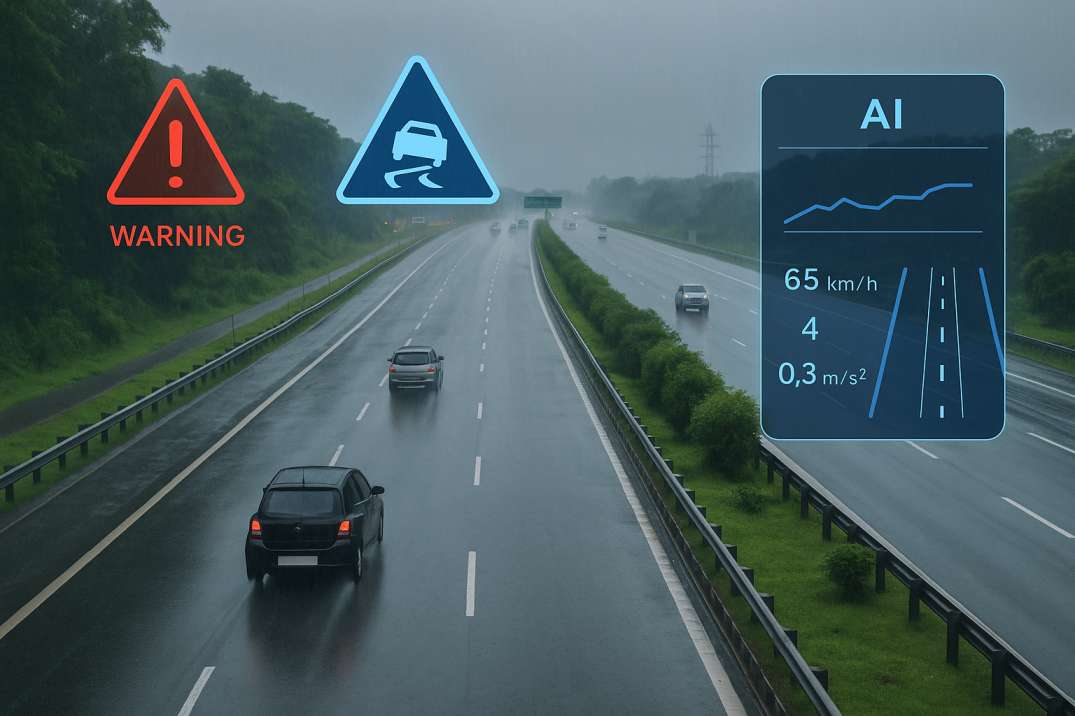Contact Us
RoadVision AI
Private Limited
Office No. 308 & 310, B Block
Ansal Chamber - 1, Bhikaji Cama Place,
Near Engineers India Limited (EIL) Bhawan, New Delhi - 110066
© 2024 | RoadVision AI | All rights reserved
Every year, the Indian monsoon causes extensive damage to the country's road infrastructure. From potholes and surface cracks to complete pavement failures, monsoon rains cost authorities thousands of crores in repairs and lost productivity. Despite repeated road surveys and maintenance drives, India's road conditions often deteriorate faster than they can be repaired.
In such a scenario, AI in roads and automated road inspections offer a revolutionary solution. With real-time data collection, predictive analytics, and intelligent asset tracking, AI can not only detect early signs of deterioration but also prevent monsoon road damage before it starts.
This blog explores how artificial intelligence is transforming road asset management across India and why local authorities, contractors, and consultants are turning to AI-powered road survey systems.

The combination of poor drainage, substandard construction, and delayed maintenance makes Indian roads highly vulnerable to water-related damage. Key issues include:
According to MoRTH guidelines and IRC SP:102-2014, regular condition assessments are mandatory to maintain road network health, especially in the pre- and post-monsoon seasons. However, manual inspections are time-consuming and often inconsistent.
Artificial Intelligence (AI) in the context of roads refers to the use of machine learning models, computer vision, and sensor data to perform tasks like pavement condition analysis, traffic volume measurement, inventory inspection, and road safety audits automatically.
Platforms like RoadVision AI use dashcam video, GPS, and sensor data to produce accurate, automated, and scalable surveys.
Using high-definition cameras and AI algorithms, solutions like RoadVision’s Pavement Condition Survey can detect:
Such defects can be mapped and prioritized for pre-monsoon repair, reducing risks of catastrophic failure.
AI platforms analyze historical data and current road health to predict which road segments are most vulnerable. This enables:
Traditional inspections cannot cover long stretches quickly. With AI-enabled dashcams and mobile mapping, automated road inspections can cover hundreds of kilometers daily, ensuring faster diagnosis and minimal disruption to traffic.
Besides infrastructure health, monsoon season also increases accident risk. Road safety audits backed by AI highlight:
These insights help agencies take immediate action to reduce crashes during adverse weather.
In several Indian smart cities and highway projects, RoadVision AI has been deployed to scan roads before and after the monsoon. Authorities reported:
Traffic surveys help determine how road load will be impacted during peak rainfall. AI detects traffic stress patterns and correlates them with pavement failure, making route planning more efficient.
Traditional maintenance methods are unable to match the pace of road deterioration, especially during heavy monsoon years. With increasing rainfall intensity due to climate change, AI provides the only scalable and proactive approach to road asset management.
AI is not just a futuristic tool—it’s the present-day necessity for saving India’s roads from repeated monsoon damage. From automated road inspections to predictive modeling and road safety audits, AI helps authorities plan, respond, and build longer-lasting infrastructure.
RoadVision AI is revolutionizing the way we build and maintain infrastructure by leveraging the power of AI in roads to enhance road safety and optimize road management. By utilizing cutting-edge roads AI technology, the platform enables the early detection of potholes, cracks, and other road surface issues, ensuring timely maintenance and improved road conditions. With a mission to create smarter, safer, and more sustainable roads, RoadVision AI ensures full compliance with IRC Codes, empowering engineers and stakeholders to make data-driven decisions that reduce costs, minimize risks, and improve the overall transportation experience.
If you're a government agency, infrastructure consultant, or private contractor, now is the time to adopt AI-driven road surveys.
Book a demo with RoadVision AI and discover how we can safeguard your road network against monsoon damage.
Q1. How does AI detect road damage caused by monsoon rains?
AI systems use cameras, sensors, and deep learning to identify cracks, potholes, and drainage failures in real-time, even before human eyes can.
Q2. Is AI-based road surveying approved under Indian regulations?
Yes. As per MoRTH and IRC SP:102 guidelines, digital condition surveys and asset mapping are recommended for modern road maintenance programs.
Q3. Can AI help local PWDs and municipalities with road maintenance?
Absolutely. AI tools scale easily and offer affordable solutions for small and large agencies to monitor roads during and after the monsoon.